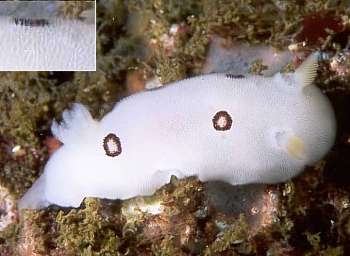
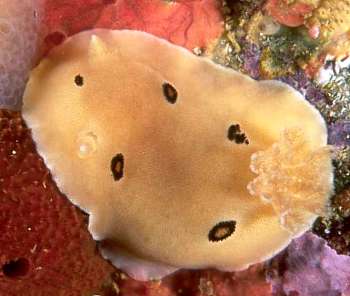
Diaulula sandiegensis
(Cooper, 1862)
Order: NUDIBRANCHIA
Suborder: DORIDINA
Superfamily: EUDORIDOIDEA
Family: Dorididae
DISTRIBUTION
From Alaska to Baja California, Mexico. Also reported from Japan.
PHOTO
Two colour forms. San Miguel Island off Santa Barbara, California, 60 feet. July 2000. Photos: Bruce Wight.
Mantle has velvety appearance, similar to Rostanga and Jorunna, caused my minute spiculate papillae (caryophyllidia). Ranges in colour from white to yellow-brown with scattered brown rings or blotches. Grows to 10 cm in length.
Reference:
• Cooper, J.G. (1862). Some new genera and species of Californian mollusca. Proceedings of the Californian Academy of Natural Sciences, 2: 202-207
Rudman, W.B., 2000 (July 4) Diaulula sandiegensis (Cooper, 1862). [In] Sea Slug Forum. Australian Museum, Sydney. Available from http://www.seaslugforum.net/find/diausand
Related messages
Variation on Diaulula sandiegensis or something else?
August 4, 2008
From: Nancy Barnett
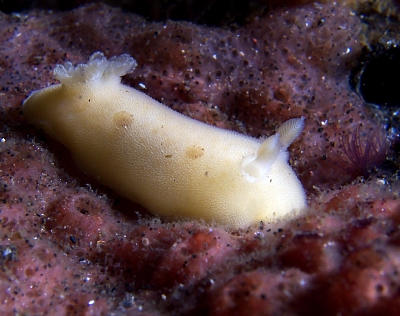
This dorid looks similar to Diaulula sandiegensis but the spots are not dark as shown in all other images posted. Is it a variation of or perhaps an immature Diaulula sandiegensis? Or is it something else?
Locality: Arch Rock, Santa Cruz Isle., Channel Islands, 45 feet, California, USA, Eastern Pacific, 22 September 2007, Intertidal, rocky. Length: 0.5 inchs. Photographer: Nancy Barnett.
Nancy Barnett
deepwater@surewest.net
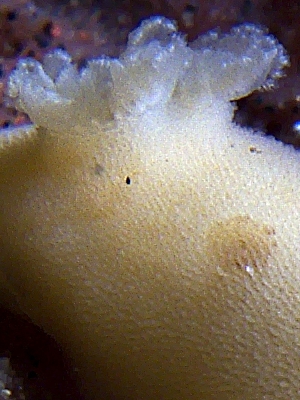
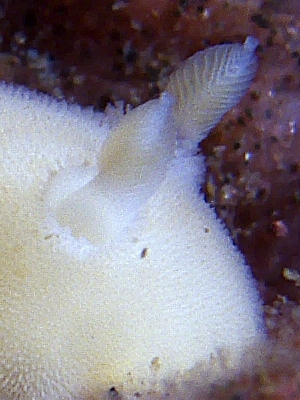
Hi Nancy,
Diaulula is a highly variable species. The number of spots varies from 4 to 40 and color of the spots can be faint as in you specimen of quite dark, even black. Your specimen is what we call Doris (s.l.) species for years. Examination of the internal anatomy showed it to be the same as Diaulula. In Bill's cropped photos the caryophyllidia (spicule bearing papillae), characteristic of this group of dorids, can be seen clearly.
-
Behrens, D.W. and A. Valdes. 2001. The identity of Doris (s.l.) species MacFarland, 1966 (Mollusca, Nudibranchia, Discodorididae): A persistent mystry from California waters. Proc. California Academy of Sciences, 52(15): 183-193.
Thanks again,
Dave Behrens
Re: Diaulula sandiegensis from British Columbia
August 14, 2007
From: Jackie Hildering
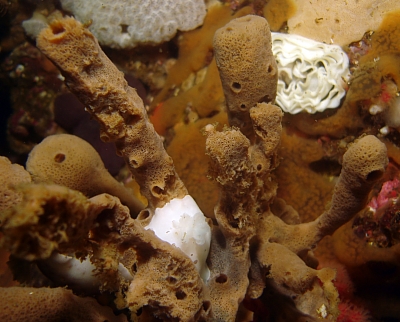
Concerning message #5322:
Thought it may be of value to the forum to have another Diaulula sandiegensis feeding and egg laying photo. In this case there are two animals feeding on the glove sponge Neoesperiopsis digitata.
Locality: Browning Wall, 45', British Columbia, Canada, Pacific Ocean, 06 August 2007 , Wall . Length: +/- 7 cm . Photographer: Jackie Hildering.
Best wishes,
Jackie
earthlingenterprises@telus.net

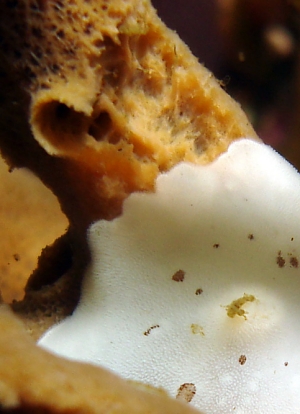
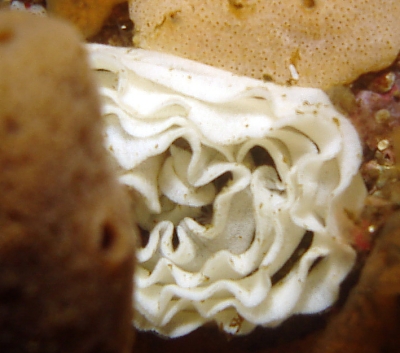
Hi Jackie,
Seems funny that a species named after San Diego, California is getting so much Canadian attention. Yes, you are correct and this is its eggs.
Thanks,
Dave Behrens
==========
Dave,
At least San Diego and British Columbia are on the same coastline. We have a common intertidal snail here in eastern Australia called Hinea brasiliana (Lamarck ,1822) because it was mistakenly thought to come from Brasil.
Cheers,
Bill
Behrens, D.W., 2007 (Aug 14). Comment on Re: Diaulula sandiegensis from British Columbia by Jackie Hildering. [Message in] Sea Slug Forum. Australian Museum, Sydney. Available from http://www.seaslugforum.net/find/20419
Diaulula sandiegensis, Laguna Beach, California
June 12, 2007
From: Tiffany Oberg
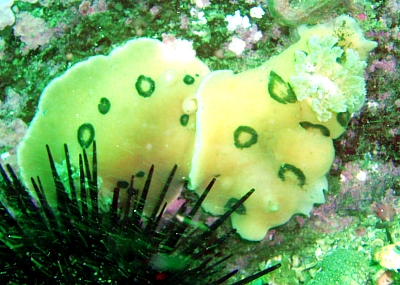
I saw these guys while diving Shaw's Cove in Laguna Beach southern California. It was a mid afternoon dive. I was about 30 feet deep when I saw them. You can kind of tell there size by the urchin next to them. I was just wondering if anybody had any ideas on the species.
Locality: Shaw's Cove, Laguna Beach, About 30 feet, CA, USA, Pacific Ocean, 30 April 2006, Sandy with rocky reef. Length: About 1 inch. Photographer: Tiffany Oberg.
Tiffany Oberg
littletiff99@hotmail.com
Oberg, T.A., 2007 (Jun 12) Diaulula sandiegensis, Laguna Beach, California. [Message in] Sea Slug Forum. Australian Museum, Sydney. Available from http://www.seaslugforum.net/find/19260Dear Tiffany,
Your species is Diaulula sandiegensis. It is the only dorid on this coast having a white to tan, fuzzy dorum (the fuzz is from the small caryophyllidia - spiculated papillae - covering the surface) and a series of large donut-like circles. A curious phenomenon in this species is that as you go further north, the number of spots seems to increase. This would make a great student project for someone to confirm.
Due to the juxtaposition of the two individuals, head to tail along their right side, I would suspect they are mating.
Best wishes,
Dave Behrens
Re: Diaulula sandiegensis from Vancouver Island
March 2, 2007
From: Brian Penney
Concerning message #19543:
Concerning the coloration/pattern of Diaulula sandiegensis in northern part of its range:
During my time in Bamfield, British Columbia, (a little bit north of Sooke), I typically found D. sandiegensis with a pattern similar to that in Minette's message in the intertidal and shallow subtidal. However, at deeper depths (5m+ is my recollection), we typically found individuals with the color pattern shown in Jim Lyle's message [#17078]. At least at the sites I dove, the two color morphs were very clearly associated with these different depths.
I also discussed this with Angel one time, and am intrigued that there are no morphological differences between the forms. This might make an interesting molecular study system to look for genetic separation among populations (as in some of Chris Todd's work).
Locality: Bamfield, B.C., 1-12m, British Columbia, Canada, Northeast Pacific, 1997-2000, boulder-cobble
Best
Brian
bpenney@anselm.edu
Penney, B.K., 2007 (Mar 2) Re: Diaulula sandiegensis from Vancouver Island. [Message in] Sea Slug Forum. Australian Museum, Sydney. Available from http://www.seaslugforum.net/find/19575Thanks Brian,
Bill Rudman
Diaulula sandiegensis from Vancouver Island
March 1, 2007
From: Minette Layne
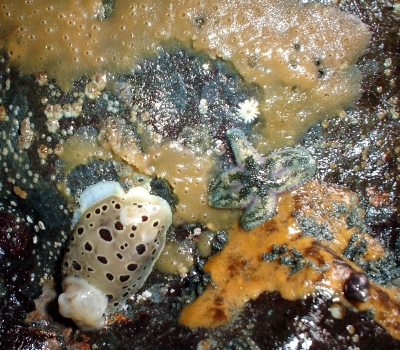
In archiving some photographs today, I came across this picture of Diaulula sandiegensis that I took in a small sea cave at Sooke on Vancouver Island.
I visited the cave every day for five days and this Diaulula was in pretty much the same place each time. The sponge, however, seemed to be disappearing! I'm not as good at identifying sponges as I should be, but perhaps this one is Halichondria panicea?
I looked at the other pictures of Diaulula on the forum, and none seem to have quite the same coloration and spot style as this little guy, so I thought it might be a useful addition to the collection. Isn't he handsome?
Locality: Sooke, Intertidal, British Columbia, Canada, Strait of Juan de Fuca, 24 June 2005, In a small sea cave. Length: 2". Photographer: Minette Layne.
Minette Layne
minette_layne@hotmail.com
Layne, M.C., 2007 (Mar 1) Diaulula sandiegensis from Vancouver Island. [Message in] Sea Slug Forum. Australian Museum, Sydney. Available from http://www.seaslugforum.net/find/19543
Hi Minette:
Yes, he (or she, whatever) is handsome. And yes, this critter is Diaulula sandiegensis. As reported by fellow Brancher, Angel Valdes and myself, as you wander north, specimens take on this darker ground color and display many more dorsal spots. We haven't a clue why, but internal examination shows that the animals are identical to those southern specimens that are very white with few spots. As they say in the US, "News at 11."
Thanks,
Dave Behrens
Diaulula sandiegensis feeding?
August 5, 2006
From: Jim Lyle
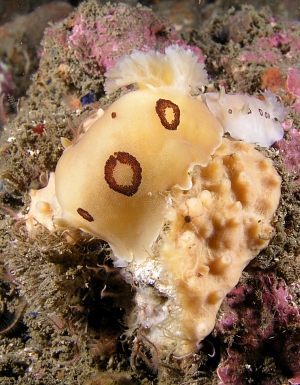
Dr. Rudman,
It looks like these Diaulula sandiegensis are feeding on a sponge (Haliclona sp?).
Locality: Palos Verdes Peninsula, 25 metres, California, USA, Pacific Ocean, 04 July 2006, rocky bottom. Length: 20 mm. Photographer: Jim Lyle.
Best,
Jim Lyle
jlyle@adelphia.net

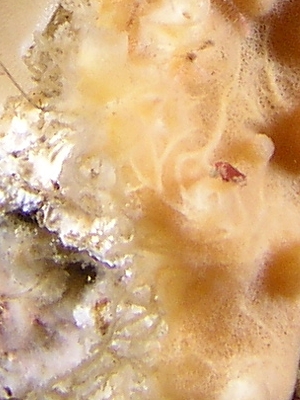
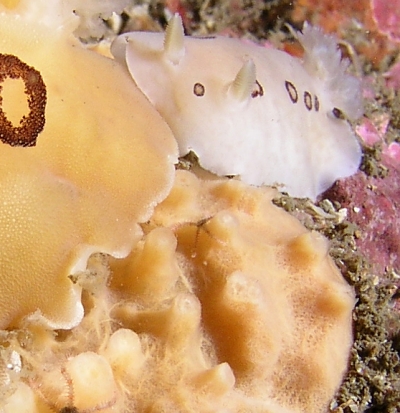
Hi Jim,
Absolutely right on. Haliclona permollis is one of several sponge species Diaulula feeds on. Others include - Halichrondria, Axinella, Mycale, Terpios and Toxadocia (according to McDonald & Nybacken's feeding monograph).
The close up of the brown ring, prepared by Bill, shows the texture of the mantle surface perfectly. Members of this genus have special tubercles called caryophyllidia, meaning the tubercles have microscopic glass spicules protruding from their tips.
As seen in your photo, color varies a lot between individuals, particularly in the number of spots and rings. Specimens at the north end of the range can have hundreds of spots.
Thanks,
Dave Behrens
Diaulula sandiegensis from Puget Sound
April 21, 2006
From: Jan Kocian
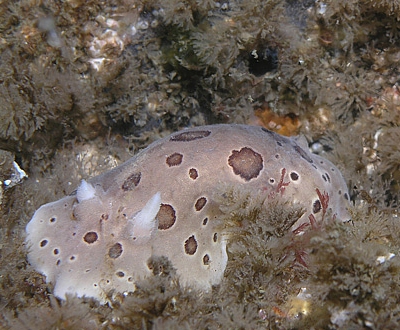
Hi Bill,
Here is the Diaulula sandiegensis, I mentioned in my Palio dubia message [#16221]. As I was zooming in on it, there was that little dorid feeding on its favored bryozoan food, Bugula nerita.
Locality: Whidbey Island, Puget Sound, 6 feet, Washington USA, Eastern Pacific Ocean, 30 March 2006, harbor seawall. Length: 22 mm. Photographer: Jan Kocian.
Jan.
honkoc@hotmail.com
Kocian, J., 2006 (Apr 21) Diaulula sandiegensis from Puget Sound. [Message in] Sea Slug Forum. Australian Museum, Sydney. Available from http://www.seaslugforum.net/find/16400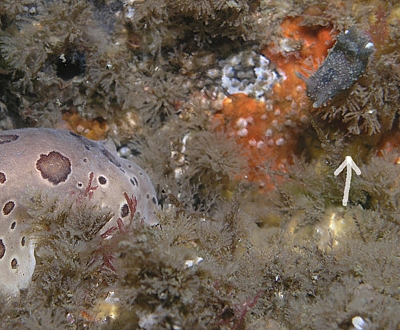
Thanks Jan,
Bill Rudman
Diaulula sandiegensis from British Columbia
January 23, 2006
From: Marli Wakeling

Hi Bill,
Here's a rather nice Diaulula sandiegensis from Northern Vancouver Island.
Locality: Plumper Rock, Broughton Archipelago, British Columbia, Canada.
Pacific coast. Depth: 40 feet. Length: 60 mm. 21 May 2005. Rocky wall
Photographer: Marli Wakeling
Cheers,
Marli
scubamarli@excite.com
Wakeling, M., 2006 (Jan 23) Diaulula sandiegensis from British Columbia. [Message in] Sea Slug Forum. Australian Museum, Sydney. Available from http://www.seaslugforum.net/find/13985Dear Marli,
Yes, this is a nice specimen. It is interesting to note the the size and number of spots in this species varies greatly with longitude (Behrens & Valdes, 2001). At the risk of over generalizing, the number of spots is greater in the northern reaches of it's range.
-
Behrens, David W., and Angel Valdes. 2001. The identity of Doris (s.l.) species, MacFarland, 1966 (Mollusca, Nudibranchia, Discodorididae): A persistent mystery from California waters. Proceediings of the California Academy of Sciences 52(15):183-193.
Best wishes,
Dave Behrens
Diaulula sandiegensis crawling over brittle stars
February 9, 2005
From: Bruce Wight
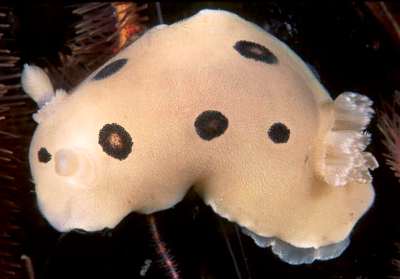
Hi Bill
While at at the oil Rigs off San Pedro, California, USA for the first time in April 2004 I came across this Diaulula sandiegensis crawling over brittle stars.
Take care,
Bruce Wight
bruce.c.wight@boeing.com
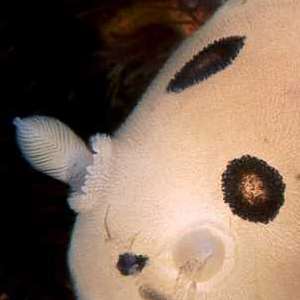
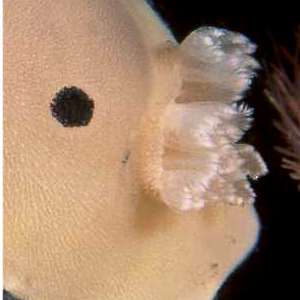
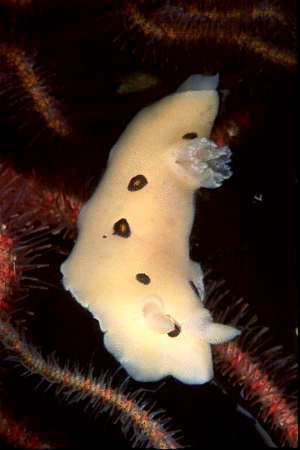
Thanks Bruce,
This Diaulula wasn't going to let the brittle stars interrupt its travels. I've included a couple of close-ups to show the bristles [caryophyllidia] which cover the mantle.
Best wishes,
Bill Rudman
Diaulula sandiegensis from Santa Barbara Island
July 1, 2003
From: Chris Grossman
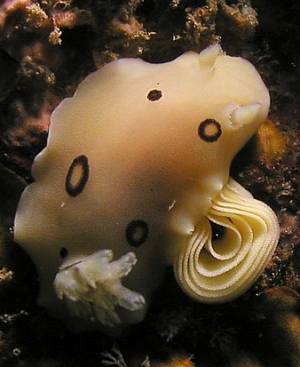
Dear Bill,
Here are some photos I took of Diaulula sandiegensis at Farnsworth Bank, just West of Catalina Island, California, on June 21 2003.
Chris Grossman
chris@diver.net
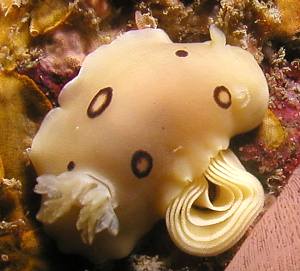
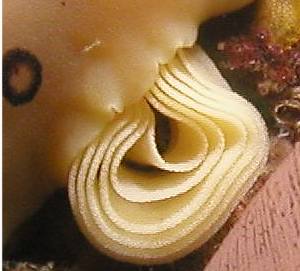
Thanks Chris,
I guess it is in the proess of laying those eggs
Best wishes,
Bill Rudman
Re: Diaulula sandiegensis from British Columbia
April 7, 2003
From: Brian Penney
Dear Bill,
Concerning Jackie & Glen's message about the food of Diaulula sandiegensis. Haliclona cf. permollis is one of its major food items in the intertidal from what I've seen in Bamfield, British Columbia. This is also what Bloom (1974) found from his work in Washington State. In the intertidal Haliclona typically occurs in crevice microhabitats, presumably to reduce dessication risk, and seems to co-occur with prosobranch eggs quite frequently.
There is a purplish sponge in the lower left of their photo which looks like this species but I am not sure if it lives at the depth mentioned by Jackie & Glen. I am curious if they are sure about the depth? As you might know, D. sandiegensis has two coloration patterns: either the leopard spotted form in Jackie and Glen's photo, or the ring form on your Fact Sheet. Typically, I don't find the leopard spot form deeper than about 25' (8m) or larger than approximately 4cm; I find the ring form from about 20' to 60', and almost always larger than 4cm. Several of us are curious just how different the two forms are in distribution, habits, size, etc. Julia Kubanek once told me the two forms seem to have different secondary chemicals as well.
Reference:
• Bloom, S. A. 1981. Specialization and noncompetitive resource partitioning among sponge-eating nudibranchs. Oecologia, 49: 305-315.
Cheers
Brian
bpenney@ualberta.ca
Thanks Brian,
I wonder if this is the 'Doris echinata O'Donoghue, 1922' that Dave Behrens discusses in his earlier message? It would be interesting to know if the colour forms are depth related, or for that matter separated by some other parameter. It would be interesting to hear of other observations on these two colour forms
Cheers,
Bill Rudman
Diaulula sandiegensis from British Columbia
April 3, 2003
From: J. Hildering & G. Miller

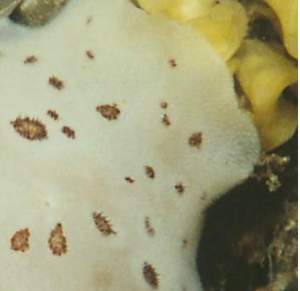
Dear Bill,
Queries:
• Is this Diaulula sandiegensis as the branchial plumes are absent?
• Could it be feeding on the Leafy Hornmouth (Ceratostoma foliatum) eggs?
Site: Bear Cove - Port Hardy (British Columbia, Canada). Depth: 35'. Feb 9th, 2003
Photo: Glen Miller
Jackie Hildering & Glen Miller
earthent@telus.net
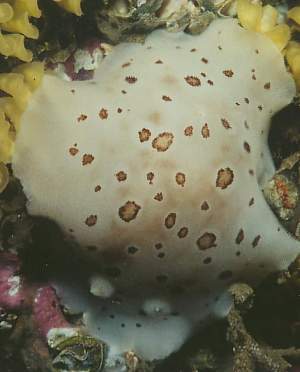
Dear Jackie & Glen,
From the 'bristles' on its back and the brown ring-like spots I would agree that this is Diaulula sandiegensis. I don't know how 'permanent' the absence of gills is. Most of the large flat sponge-feeding dorids you will come across have a special gill pocket into which the gills can contract. They can say contracted for some time so its possible that's why you didn't see them. Alternatively something may have bitten them off - not that common but it can happen. Most nudibranchs can survive quite a bit of damage and regrow lost parts. They can 'breathe' to some degree through their skin, so I guess as long as your Diaulula wasn't planning to participate in some animal Olympics, it would survive.
Concerning the eggs. To those not familiar with the name Ceratostoma foliatum, it is a muricid snail but please don't ask me why it has such an ugly common name - Leafy Hornmouth. I very much doubt it will have been eating their eggs. Like most last dorids, it is a sponge feeder, and will no doubt only eat one or a few particular species of sponge.
Best wishes,
Bill Rudman
Diaulula sandiegensis from Shaw's Cove
January 30, 2002
From: Bruce Wight
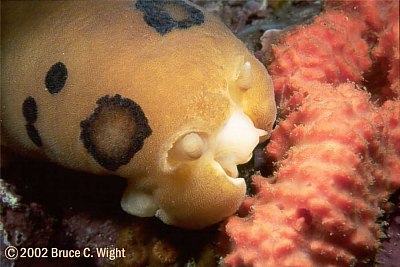
Hi Guys,
Here are some more photos from our recent dive [January, 2002] at Shaw's Cove in Laguna Beach [California]. In the 25 years of diving Shaw's I have never seen Diaulula sandiegensis there. They are fairly common south and north of there but this is the first one for me in Laguna Beach. It was very large, in excess of 16 centimeters at 44 feet. The attached image appears to show it feeding on a sponge and was shot with a Nikonos with a 1:2 tube which provides a sense of scale for the animal. Take care,
Bruce Wight
bwproductions@earthlink.net
Wight, B., 2002 (Jan 30) Diaulula sandiegensis from Shaw's Cove. [Message in] Sea Slug Forum. Australian Museum, Sydney. Available from http://www.seaslugforum.net/find/6118Thanks Bruce,
This animal has clearly sustained some damage to the front of its mantle skirt, which is quite useful as it allows us to see the white head with its small oral tentacles. The head is usually hidden beneath the mantle skirt.
Best wishes,
Bill Rudman
Doris s.l. MacFarland, 1966
November 10, 2001
From: Dave Behrens

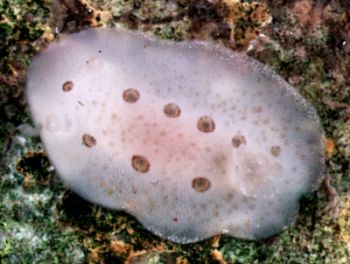
Bill:
Just a note to make your California readers aware of a recent synonymy to Diaulula sandiegensis (Cooper, 1863).
Angel Valdes and I have just published a paper placing 'Doris s.l. species'
(photos of what we have typically called Doris s.l. are provided here) and
Doris odonoghuei under Diaulula sandiegensis (Cooper, 1863). For some time I had thought that Doris s.l. species MacFarland, 1966, was a valid and distinct species and should receive proper designation, having not been
proposed as a specum novum, nor was a holotype designated. We sought to do so since, the International Code of Zoological Nomenclature (ICZN, 1999) requires that the specific name consist of one word only and prohibits the use of single letters for species-group names, and the use of the word
"species" as a specific name, although not denied by the Code, was in my opinion inappropriate. As you know the name Doris (s.l.) species MacFarland (1996) has been carried in the literature in numerous publications even though nomenclaturally incorrect by ICZN rules.
Comparing the internal anatomy of specimens with the identical coloration of the specimens pictured here and by MacFarland, with variations of Diaulula sandiegensis (Cooper, 1863) we found is that the internal features of Doris (s.l.) species, including reproductive system and radular characteristics, fit perfectly those of Diaulula sandiegensis, described much earlier. Externally the variation in the ground color of the notum in Diaulula sandiegensis (white to pale yellow) and the degree dorsal spotting (from a very few donut shaped spots to hundreds of smaller spots) encompass that of Doris (s.l.). The caryophylidia are identical in the two species.
While preparing our manuscript, we also considered another a species with similar external characteristics described as Doris echinata by O'Donoghue in 1922. Iredale & O'Donoghue (1923) reassigned this species to Doridigitata d'Orbigny, 1839, and changed the name (without explanation) to Doridigitata maculata. Steinberg (1963) recognized that both the O'Donoghue names were preoccupied by Doris echinata Loven 1846 and Doris maculata Garstang 1896, respectively, and proposed a new name, Doris odonoghuei for this species. In that paper she questions it's accurate placement in Doris and suggests further study. The O'Donoghue (1922) description of Doris echinata was brief, and there was no description of the reproductive system. O'Donoghue stated that though he felt that the classification of the family was unsatisfactory, D. echinata fell within the definition. Steinberg (1963) in proposing the name Doris o'donoghuei to rectify the preoccupancy issue of the names, discussed earlier, examined two specimens from the collection of the Friday Harbor Marine Laboratories. Questioning the assignment of the species to Doris, she dissected the smaller of the two but came to no satisfactory conclusion. Since that time no published accounts or casual observations have been made of this species. Dr. Sandra
Millen tells us that she had never collected specimens, in the Vancouver, British Columbia area, she could clearly identify as D. odonoghuei, finding it impossible to distinguish it from small Diaulula sandiegensis. Angel and I suggest that this species is species dubium.
Photos: Orange County, California, Intertidal, 15mm (D.W. Behrens).
References:
• BEHRENS, DAVID W. and ANGEL VALDES. 2001. The identity of Doris (s.l.)species MacFarland,1966 (Mollusca, Nudibranchia, Discodorididae): A persistent mystery from California solved. Proceedings of the California Academy of Sciences: 52(15): 183-193.
• MACFARLAND, FRANK MACE. 1966. Studies of the Opisthobranchiate Mollusks of the Pacific coast of North America. Memoirs of the California Academy of Sciences. Vol. 6. San Francisco.
Dave Behrens
Dave@seachallengers.com
Behrens, D.W., 2001 (Nov 10) Doris s.l. MacFarland, 1966. [Message in] Sea Slug Forum. Australian Museum, Sydney. Available from http://www.seaslugforum.net/find/5639Thanks Dave,
This may seem a strange thing to write a paper on. As an explanation to those of you with little experience in nomenclature here is a brief explanation. 's.l.' is an abbreviation for the Latin phrase 'sensu lato' which simply means 'in a loose sense', as opposed to 's.s.' which is an abbreviation for 'sensu stricto' which means 'in a strict sense'. These terms are used as nomenclatural shorthand much like 'cf'. I am sure Macfarland was not introducing a new name when he labelled this beast Doris s.l.. All he was saying was that it seemed to be a distinct species of dorid, which superficially looked like a species of Doris.
Best wishes,
Bill Rudman
Sponge prey of Diaulula sandiegensis
September 28, 2001
From: Jeff Goddard
Hi Bill,
Concerning Marli Wakeling's photo of Diaulula sandiegensis feeding on an "orange finger sponge." The red-orange finger sponges from the shallow subtidal in the northeastern Pacific are Neoesperiopsis digitata and N. vancouverensis. I have observed Diaulula sandiegensis from Cape Arago, Oregon feeding in the lab on the intertidal species, N. rigida.
Best wishes,
Jeff
goddard@lifesci.ucsb.edu
Goddard, J., 2001 (Sep 28) Sponge prey of Diaulula sandiegensis. [Message in] Sea Slug Forum. Australian Museum, Sydney. Available from http://www.seaslugforum.net/find/5350Thanks Jeff,
Bill Rudman
Diaulula sandiegensis food sponge
September 28, 2001
From: Marli Wakeling
Hi Bill,
Sorry I didn't include it in my first message: the orange finger sponge is listed in Gotshall's book Guide To Marine Invertebrates as Neoesperiopsis sp. In Pacific Coast Nudibranchs, Behrens states it feeds on Halichondria and Haliclona species, but in Howe Sound and Agamemnon Channel, I have always found them on the Neoesperiopsis type of sponge. In fact, there seems to be a cycle of sponge abundance and depletion in the former location every two years. Until recently, I thought it was due to pollution. I'm starting to think it might be related to these nudibranchs.
Marli
scubamarli@excite.com
Wakeling, M., 2001 (Sep 28) Diaulula sandiegensis food sponge. [Message in] Sea Slug Forum. Australian Museum, Sydney. Available from http://www.seaslugforum.net/find/5351Thanks Marli,
Bill Rudman
Diaulula sandiegensis from British Columbia
September 27, 2001
From: Marli Wakeling


We found two of these on their orange finger sponge food, laying egg ribbons.
Date: October 2000
Location: Crimson Wall, Agamemnon Channel, Sechelt Penninsula, British Columbia, Canada.
Depth: 6 metres
Length: 10 cm.
Marli Wakeling
scubamarli@excite.com
Wakeling, M., 2001 (Sep 27) Diaulula sandiegensis from British Columbia. [Message in] Sea Slug Forum. Australian Museum, Sydney. Available from http://www.seaslugforum.net/find/5322Thanks Marli,
Do you know the species of sponge it eats in your part of its range by chance?
Bill Rudman.
Colour forms of Diaulula sandiegensis
August 5, 2000
From: Bruce Wight


Dear Bill,
Here are photos of the white and the yellow color variations of Diaulula that I mentioned seeing on a trip to San Miguel Island off Santa Barbara, California last weekend. We were diving in about 60 feet of water which was a cool 53 degrees.
Bruce Wight.
bwproductions@earthlink.net
Wight, B., 2000 (Aug 5) Colour forms of Diaulula sandiegensis. [Message in] Sea Slug Forum. Australian Museum, Sydney. Available from http://www.seaslugforum.net/find/2834Thanks Bruce,
Bill Rudman.
Diaulula sandiegensis from British Columbia
June 12, 2000
From: Marli Wakeling
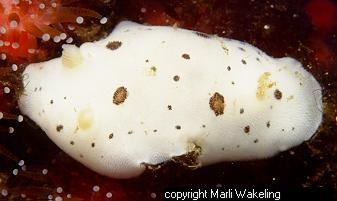
Dear Bill,
Here is Diaulula sandiegensis. This animal is a little larger than most I seek, about 4-10 cm. in length. It is noted for its fuzzy appearance and brown dots which may or may not have a white centre. Found in Campbell River, British Columbia, on Vancouver Island. [British Columbia, Canada].
Marli Wakeling
scubamarli@excite.com
Wakeling, M, 2000 (Jun 12) Diaulula sandiegensis from British Columbia. [Message in] Sea Slug Forum. Australian Museum, Sydney. Available from http://www.seaslugforum.net/find/2505Thanks Marli,
Bill Rudman.
